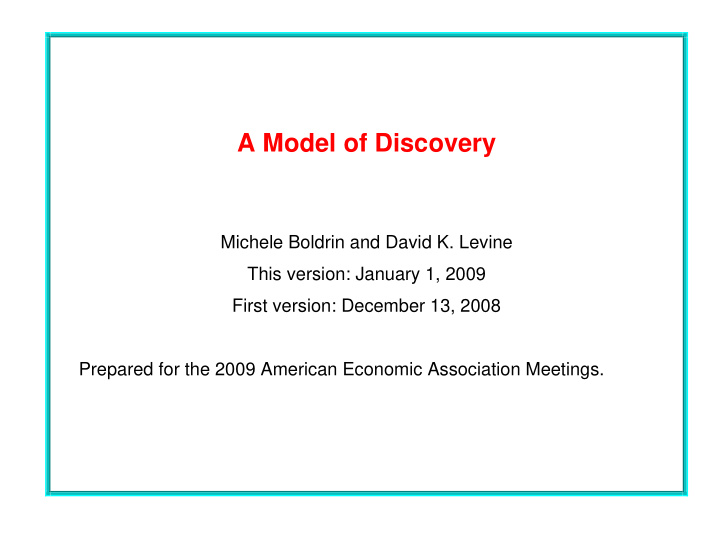



A Model of Discovery Michele Boldrin and David K. Levine This version: January 1, 2009 First version: December 13, 2008 Prepared for the 2009 American Economic Association Meetings.
Introduction � Empirical evidence: patents do not have much impact on innovation � Bessen and Meurer [2008], Lerner [2008], Mokyr [2008], etc. � True in capital ladder models: Scotchmer [1991], Boldrin and Levine [2004], Llanes and Trento [2008] � Only a long-run downstream consequence � innovation discouraged when there are many existing patents � Lerner [2008] shows even in short-run no increase in innovation 1
Existing Theory � essentially a static theory � incurring fixed cost creates a unit of knowledge available to all for free � “Schumpeterian models” such as Aghion and Howitt [1992] simply stack a sequence of these static models end-to-end � two assumptions: � fixed cost of creation � free availability of newly created knowledge � Boldrin and Levine [2002, 2008b] challenge the free availability assumption and the evidence against it can be found in Boldrin and Levine [2008a] 2
Is Creation Properly Modelled by a Fixed Cost? � “eureka” theory of discovery: you work and work and have nothing � one day you wake up and you have a fully developed discovery � what is true � innovators work on new ideas for some period of time before marketing them or implementing them in new products � after ideas are brought to market, the process of creating original knowledge is replaced by the process of making cheap copies � we present a standard diminishing returns model with these properties � intermediate output: unfinished notes, knowledge of dead-ends that have been encountered, the computer program with many bugs can have value in consumption, but have a great deal more value in the process of further knowledge creation 3
A Model of Creation and Copying Continuous time � � � � � market for a new product that did not previously exist consumers derive utility � � � � � � � � � � � � � � �� . � � � � Where � � is consumption and labor � � � � � strictly increasing, finite, strictly concave, and twice continuously differentiable for � � ��� �� � � � � � � � � THIS IS IMPORTANT – tiny amount of consumption have ���� � limited usefulness to the consumer 4
Knowledge Capital knowledge encapsulated in blueprints � � � � initially no blueprints � � � � original knowledge creation technology creates blueprints from labor and blueprints cannot be Cobb-Douglas – must be possible to produce blueprints from labor alone perturbed Cobb-Douglas � � � � � � � � � � � � �� �� � , and �� � �� �� � � � � � � � � � � � � blueprints and labor used in original knowledge creation � �� � � � � �� � 5
Blueprints in Original Creation of Knowledge IMPORTANT: once some labor is allocated to the original creation process, the marginal product of blueprints is very high (infinite at ) � � � � 6
Cheap Copies and Consumption a technology for the inexpensive copying, or imitation, of blueprints , where � and �� � are the blueprints used for making � � �� � � � �� �� copies blueprints can be used to produce a flow of consumption units chosen so that � where �� � are blueprints used to produce � � � �� consumption 7
Summary Equation of motion for blueprints � � � � � � � � � � � � � � � � � � � � � � �� � � � �� along with the constraints � � � � � �� � � � � � � � � �� � � � � �� add a technical assumption on utility that rules out infinite utility 8
Characterizing the Optimal Plan You only use original creation at the beginning Proposition 2 : There is a time such that if � then in the � � � � � � � optimal plan . � � � � � �� �� You never use original creation at the end Proposition 3: In the optimal plan: � � is increasing, ��� , �� � � � � � � � �� and ��� . � � � � � � �� � �� 9
When Copy? Definition 4: We say that demand is strong asymptotically if . � � � � � � � � � � � � If demand is “big enough” you switch to copying Proposition 5: If demand is asymptotically strong, then in the optimal plan ������ � � � �� � 10
Impact of Monopoly on Innovation This is a standard diminishing returns economy: competition give the first best Monopoly (and IPRs) can only make things worse Suppose a single monopolist controls the market and maximizes the present value of her profits Amounts to replacing � with � � � � �� � � � � � � � � � � � � � � Produce less output � So produce less capital � So use less labor = less R&D � May also go to market earlier as ���� . � ���� � � � 11
The “Public-Private Partnership” universities are encouraged to patent ideas developed using government funding implications of awarding a monopoly: � less research done at universities � results of the research that is done made made available to industry sooner it is claimed that the “public-private partnership” has been a great success because of the latter in this model, it is unambiguously bad scientific resources are misallocated to industrial applications when it would be better to use them in producing more original research that would reach industrial fruition later 12
Recommend
More recommend